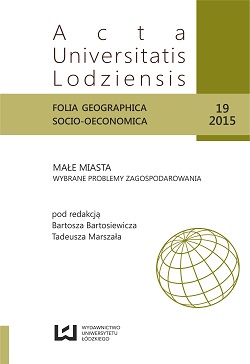Odwołania do tradycji we współczesnej architekturze aglomeracji poznańskiej jako szansa na poprawę jakości przestrzeni
DOI:
https://doi.org/10.18778/1508-1117.19.02Słowa kluczowe:
tradycyjna architektura, dziedzictwo kulturowe, architektura wernakularna, tożsamość architektoniczna, degradacja przestrzennaAbstrakt
Proces degradacji przestrzennej małych miast i wsi stanowi złożony problem, który został w sposób szkicowy omówiony w pracy. Receptą na uporządkowanie przestrzeni jest w opinii autora m.in. pielęgnowanie wiedzy o tożsamości kulturowej regionu poprzez nawiązywanie w architekturze do lokalnej tradycji. W artykule zaprezentowane zostały nieliczne udane realizacje i modernizacje budynków, których architektura nawiązuje do kultury i tradycji Wielkopolski.
Bibliografia
Beim M., 2007, Modelowanie procesu suburbanizacji w aglomeracji poznańskiej z wykorzystaniem sztucznych sieci neuronowych i automatów komórkowych, http://www.academia.edu/2990732/Modelowanie_procesu_suburbanizacji_w_aglomeracji_poznanskiej_z_wykorzystaniem_sztucznych_sieci_neuronowych_i_automatow_komorkowych (dostęp: 5.12.2013).
Google Scholar
Brencz A., 2007, Zróżnicowanie kultury ludowej Wielkopolski – szkic etnograficzny, [w:] Granica, Poznań, s. 31–46.
Google Scholar
Burszta J. (red.), 1964, Kultura ludowa Wielkopolski, t. 2, Warszawa.
Google Scholar
Głowacki T., 2012, Wiejska świetlica w Rakowni, „Architektura-Murator”, 5, s. 70–75.
Google Scholar
Jakimowicz T. (red.), 1994, Architektura niedostrzegalna. Budownictwo folwarczne Wielkopolski, Poznań.
Google Scholar
Palacz T., 2012, Dziedzictwo wsi wielkopolskiej – stan zachowania, zagrożenia oraz działania zmierzające do jego ochrony, „Architektura Krajobrazu”, 2, s. 109–123.
Google Scholar
Parysek J.J., 2008, Aglomeracje miejskie w Polsce oraz problemy ich funkcjonowania i rozwoju, [w:] Wybrane problemy rozwoju i rewitalizacji miast: aspekty poznawcze i praktyczne, seria: Rozwój Regionalny i Polityka Regionalna, nr 5, Poznań, s. 38.
Google Scholar
Radziewanowski Z., 2005, O niektórych problemach regionalizmu i ekologii w architekturze i urbanistyce, Kraków.
Google Scholar
Raszeja E. (red.), 2002, Obszary wiejskie – problemy, projekty, wizje, Poznań.
Google Scholar
Raszeja E., Wilkaniec A., de Mezer E., 2010, Krajobraz i dziedzictwo kulturowe wsi w aglomeracji poznańskiej, seria: Biblioteka Aglomeracji Poznańskiej, z. 3, Poznań.
Google Scholar
Rejestr zabytków województwa wielkopolskiego, http://www.nid.pl/pl/Informacje_ogolne/Zabytki_w_Polsce/rejestr-zabytkow/zestawienia-zabytkow-nieruchomych/WLK-rej.pdf (dostęp: 2.10.2013).
Google Scholar
Strategia rozwoju aglomeracji poznańskiej, 2011, Centrum Badań Metropolitalnych, Poznań, http://metropolia2020.poznan.pl/tresc-dokumentu (dostęp: 5.12.2012).
Google Scholar
Wrana J., 2011, Tożsamość miejsca. Kryterium w projektowaniu architektonicznym, Lublin.
Google Scholar
Zgodziński B., 1977, Gościńce i zajazdy Wielkopolski, Poznań.
Google Scholar
Pobrania
Opublikowane
Jak cytować
Numer
Dział
Licencja

Utwór dostępny jest na licencji Creative Commons Uznanie autorstwa – Użycie niekomercyjne – Bez utworów zależnych 4.0 Międzynarodowe.








